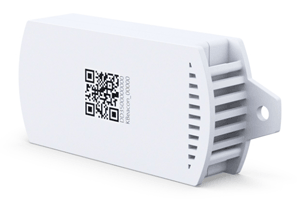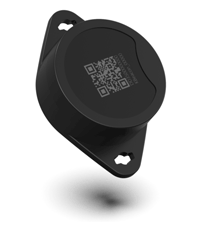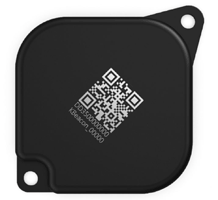What Are BLE Tags And BLE Beacons
Bluetooth low energy tags (BLE beacon tags), and how you can use them for the smart asset and inventory tracking.
BLE asset tags are Bluetooth low energy (BLE) beacons. BLE beacons broadcast data that nearby Bluetooth devices
can pick up and interpret. In the case of the asset and inventory tracking a BLE beacon tag broadcasts an ID number that uniquely identifies an asset
or inventory item. The devices that listen to the BLE beacon tags can be smartphones or Bluetooth IoT gateways. Listening devices can
do data processing and batching in place, and send updates to the backend cloud software. A cloud software
takes care of data storage and reporting.
BLE Tags Characteristics
BLE tags characteristics, from battery life, to scanning range, to size and weight.
BLE Tags Battery Life
BLE tags are powered by the small coin-size batteries. The bluetooth low energy protocol was
designed to save energy. Because of the low BLE power consumption the battery in the BLE tag can last for several years.
Some BLE tags have replaceable batteries.
Many BLE tags vendors give you an option to configure BLE tag parameters, such as transmission signal strength and broadcast interval.
Using these options you can select your own trade offs between BLE tag responsiveness (broadcast interval), distance (signal strength) and
a battery life.
BLE Tags Scanning Range
BLE scanning range is a distance at which a signal can be picked up by the Bluetooth receiver.
On average, BLE asset tags have a scanning range
between 30 and 80 meters in the open space. Any walls or obstructions reduce this distance.
The distance at which a BLE tag signal can be picked up depends on both a tag and a Bluetooth receiver.
Industrial BLE Tags
Industrial BLE tags are rugged, waterproof devices that are suitable for construction tools and equipment in outdoor conditions.
Industrial asset tags IP rating is between IP65 and IP67. This rating means that BLE tags can withstand dust, forein particles,
and water jets from low pressure to high pressure. IP67 rated BLE tags can be completely submerged into the water for the short time period.
BLE Tags Size And Weight
BLE asset tag is a small lightweight plastic tag, round, square, or rectangular. The tag size may
range between one and two inches, and thickness is around half an inch or less.
BLE tags are suitable for putting on the small equipment, tools, and other assets, as well as on or inside inventory bins, totes, or boxes.
You can attach a BLE tag to the asset with a zip tie or screws. Some BLE tags have an adhesive surface that allows you to stick a tag to the asset.
You can also put BLE tags on or inside boxes or bins for tracking small inventory items.
A Smart Asset Tracking System With BLE Tags
A QR Inventory software supports asset tracking using BLE tags. You can scan BLE tags with a mobile app, or use a
Bluetooth IoT gateway for
a fully automated asset tracking.
Bluetooth low energy (BLE) is becoming a less expensive and more robust alternative to RFID for the asset and inventory tracking.
Components Of BLE Asset Tracking System
You need three components for the
smart IoT asset tracking
using BLE technology:
BLE Tags
Asset tracking BLE tags are Bluetooth low energy beacons that broadcast asset identification number.
Each trackable asset should have a BLE tag attached to it. BLE tags do not have to be visible or in line of sight to be scanned. Tags
can be inside the cases or packaging, and they still will be detected by the Bluetooth receiver.
A Bluetooth Gateway
A Bluetooth gateway serves as a bridge between BLE tags and a back end cloud software.
It detect BLE beacons within its scanning range, processes data and sends updates to the cloud.
An employee with a smartphone can play the role of a Bluetooth gateway. You can also use a dedicated stationary gateway and not rely on
company employees for the asset tracking tasks.
Asset Management Cloud Software
A cloud software receives asset tracking data from the Bluetooth gateway or a smartphone,
processes data and
produces real time and historic reports.
BLE Tags And Sensors That Come With The QR Inventory Software
These are the most commonly used BLE tags that you can purchase along with the QR Inventory software. These BLE tags
are rugged, waterproof, and can be used both indoors and outdoors. You can use them on the construction equipment, tools, warehouse inventory and pallets,
and other trackable assets. If you need different
BLE tags for the special use cases, please
contact us.
A Rugged Waterproof BLE Asset Tag With Replaceable Battery (BLE Beacon / iBeacon Format)
A rugged weatherproof BLE tag suitable for use on the construction tools, equipment and machinery in outdoor conditions.
Use screws or a zip tie to attach it to the assets. Low power consumption, battery lasts up to four years and is replaceable. The
beacon signal transmission range is up to 100 meters in the open space.
- Dimensions: 40 mm x 64 mm x 18 mm
- Weight: 25 g
- Temperature range: from minus 40 to plus 70 degrees celsius
- Battery: replaceable, lasts up to 4 years
- Beacon signal transmission range: up to 100 m in open space
- Beacon parameters configuration: maximum signal range and beacon broadcast interval can be configured to provide the best range / interval / battery life tradeoff for the client's use case
- Waterproof level: IP65 (protected from dust and foreign particles, protected from rain, snow, condensation, low pressure water jets).
- Sensors: optionally can include temperature sensor for the automatic reporting of the asset temperature conditions, and / or accelerometer sensor
for detecting unusual equipment vibration patterns.
IP67 Waterproof BLE Asset Tag (BLE Beacon / iBeacon Format)
A waterproof BLE tag suitable for the indoor and outdoor use. This BLE tag is well suited for the inventory, assets, equipment, warehouse pallets,
or for tracking employees. Protected from the rain, snow, condensation and flooding -
can tolerate being submerged into the water for up to 30 minutes at the shallow depth.
Use zip tie to attach it to the equipment, tools, assets or inventory, place inside the inventory packaging,
or attach to the employees' tags using a key chain.
Low power consumption, battery lasts up to three years. Battery is not replaceable. The beacon signal
can be read at the distance of up to 80 meters in the open space.
- Dimensions: 37 mm x 37 mm x 8 mm
- Weight: 13 g
- Temperature range: from minus 40 to plus 70 degrees celsius
- Battery: non-replaceable, lasts up to 3 years
- Beacon signal transmission range: up to 80 m in open space
- Beacon parameters configuration: maximum signal range and beacon broadcast interval can be configured to provide the best range / interval / battery life tradeoff for the client's use case
- Waterproof level: IP67 (protected from dust and foreign particles, protected from rain, snow, condensation, high pressure water jets and submerging into the water
for up to 30 minutes at depth between 15 cm and one meter).
- Sensors: no sensor options.

BLE Temperature And Humidity Sensor (Indoors And Outdoors)
A temperature and humidity sensor with BLE beacon option can be used to monitor environmental conditions
(temperature and humidity)
of the warehouse assets and inventory, as well as
conditions on the construction sites, in the smart buildings, in the labs and on the shop floor.
Combining inventory and asset tracking
with the automatic temperature and humidity monitoring ensures that assets and inventory are stored or transported
in the correct temperature and humidity environment, prevents spoilage and waste.
The inventory and asset management system knows
the acceptable temperature and humidity range for the sensitive assets and inventory,
and in which zone each asset is located
at any moment.
As you move assets and inventory between locations, the system verifies that all assets and inventory are
in the acceptable temperature and humidity range. You receive immediate alerts if any asset or inventory item is moved in the
zone with the temperature and humidity conditions which can be harmful, or if the temperature or humidity conditions in the
zone go
out of the acceptable range for the assets and inventory which are located in this zone.
You also have an access to the temperature and humidity log for
all sensitive assets and inventory for the traceability and accountability purposes.
This temperature and humidity beacon can store up to 400 temperature and humidity values, so you always have an access
to the detailed temperature and
humidity logs even if the connection is interrupted.
- Dimensions: 94 mm x 38 mm x 18 mm
- Weight: 42 g
- Temperature range: from minus 40 to plus 70 degrees celsius, temperature measurement precision 0.3 degrees celsius
- Battery: non-replaceable, lasts up to 8 years
- Waterproof level: IP66 (protected from dust and foreign particles, protected from rain, snow, condensation and high pressure water jets).
- Sensors: temperature and humidity
- Data storage: can store up to 400 temperature and humidity records. The records can be downloaded and sent to the cloud
via a smartphone application or a Bluetooth gateway.
- Data reporting: real time data reporting via a smartphone / mobile application or Bluetooth gateway. Data can be stored on the sensor
and retrieved later if there is an
interruption in the connection.


